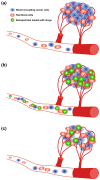Nanoparticle-Mediated Combination Therapy: Two-in-One Approach for Cancer
- PMID: 30347840
- PMCID: PMC6214025
- DOI: 10.3390/ijms19103264
Nanoparticle-Mediated Combination Therapy: Two-in-One Approach for Cancer
Abstract
Cancer represents a group of heterogeneous diseases characterized by uncontrolledgrowth and spread of abnormal cells, ultimately leading to death. Nanomedicine plays a significantrole in the development of nanodrugs, nanodevices, drug delivery systems and nanocarriers. Someof the major issues in the treatment of cancer are multidrug resistance (MDR), narrow therapeuticwindow and undesired side effects of available anticancer drugs and the limitations of anticancerdrugs. Several nanosystems being utilized for detection, diagnosis and treatment such as theranosticcarriers, liposomes, carbon nanotubes, quantum dots, polymeric micelles, dendrimers and metallicnanoparticles. However, nonbiodegradable nanoparticles causes high tissue accumulation andleads to toxicity. MDR is considered a major impediment to cancer treatment due to metastatictumors that develop resistance to chemotherapy. MDR contributes to the failure of chemotherapiesin various cancers, including breast, ovarian, lung, gastrointestinal and hematological malignancies.Moreover, the therapeutic efficiency of anticancer drugs or nanoparticles (NPs) used alone is lessthan that of the combination of NPs and anticancer drugs. Combination therapy has long beenadopted as the standard first-line treatment of several malignancies to improve the clinical outcome.Combination therapy with anticancer drugs has been shown to generally induce synergistic drugactions and deter the onset of drug resistance. Therefore, this review is designed to report andanalyze the recent progress made to address combination therapy using NPs and anticancer drugs.We first provide a comprehensive overview of the angiogenesis and of the different types of NPscurrently used in treatments of cancer; those emphasized in this review are liposomes, polymericNPs, polymeric micelles (PMs), dendrimers, carbon NPs, nanodiamond (ND), fullerenes, carbonnanotubes (CNTs), graphene oxide (GO), GO nanocomposites and metallic NPs used forcombination therapy with various anticancer agents. Nanotechnology has provided the convenienttools for combination therapy. However, for clinical translation, we need continued improvementsin the field of nanotechnology.
Keywords: anticancer drug; carbon nanoparticles; combination therapy; dendrimers; graphene oxide nanocomposites; liposomes; metallic nanoparticles; polymeric nanoparticles.
Conflict of interest statement
The authors declare no competing financial interests.
Figures









References
-
- American Cancer Society Cancer Facts & Figures 2016. [(accessed on 19 July 2018)]; Available online: https://www.cancer.org/research/cancer-facts-statistics/all-cancer-facts....
Publication types
MeSH terms
Substances
LinkOut - more resources
Full Text Sources
Other Literature Sources

